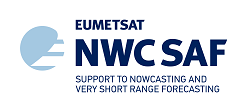An example of success case study of NWC SAF products is presented in the article: "Impact of satellite-derived cloud cover on road weather forecasts", written by Vojtech Bliznaka , Petr Zacharova , Zbynek Sokola , Petr Pesicea and Jindrich Stastkab.
This paper presents an innovative approach to road surface temperature (RST) forecasting by using satellite- derived cloud cover information as inputs for the FOrecast of Road TEmperature and condition (FORTE) road weather model (RWM). FORTE is a 1D physical based model used for solving energy balance and heat conduction equations. The new method uses the extrapolated cloud mask product calculated from Meteosat Second Generation satellite measurements to derive the forecasted cloud cover, which is then entered into the RWM. This method is based on the assumption that cloud cover extrapolated for the very near future (i.e., 1–3 h) from current conditions is able to provide more accurate input data (as compared to the currently used numerical weather prediction (NWP) model forecast) that can be used for calculating the radiation fluxes in the RWM. The resulting RSTs were verified over a 2-month period from December 2021 to January 2022 at road weather stations located on 4 selected Czech motorways. The obtained results showed that the innovated model run using satellite-derived cloud cover generated RSTs closer to the observed values, in contrast to the original model run, whose predictions have larger errors. The greatest improvement is evident during the day, when solar radiation dominates, and especially in the 2nd and 3rd forecasted hours, when extrapolated cloud cover helps to reduce the morning overestimation and afternoon underestimation of RSTs. If the NWP model incorrectly predicts clouds over the road surface on cloudless nights, the emitted downwards radiation from the clouds towards the Earth's surface is increased in the RWM, which leads to an overestimation of the RSTs. On the other hand, incorrectly predicting clear skies leads to a negative radiation balance in the RWM, which typically results in RSTs that are lower than the observations.
a Institute of Atmospheric Physics CAS, Department of Meteorology, Prague, Czech Republic.
b Czech Hydrometeorological Institute, Prague, Czech Republic.
